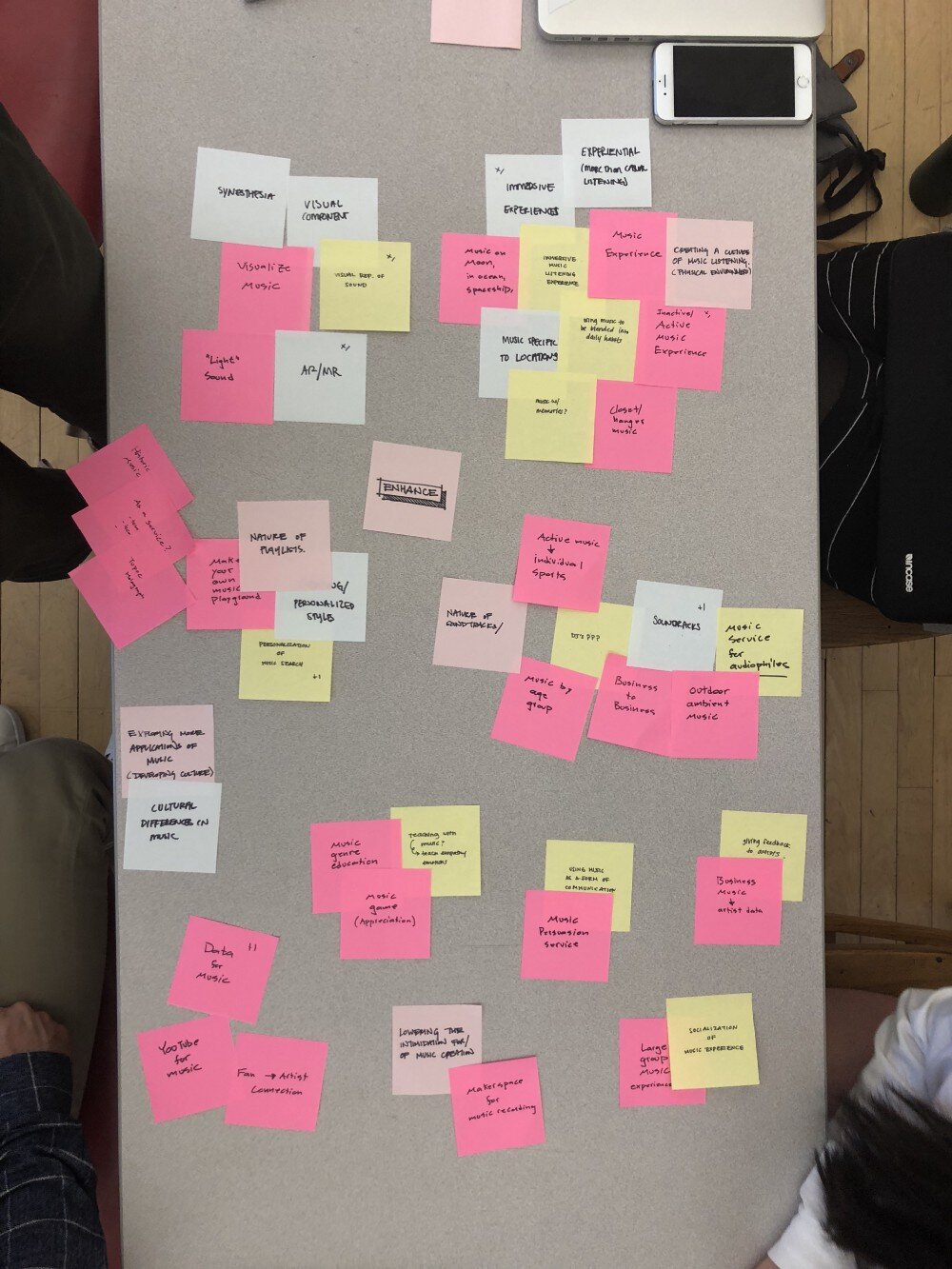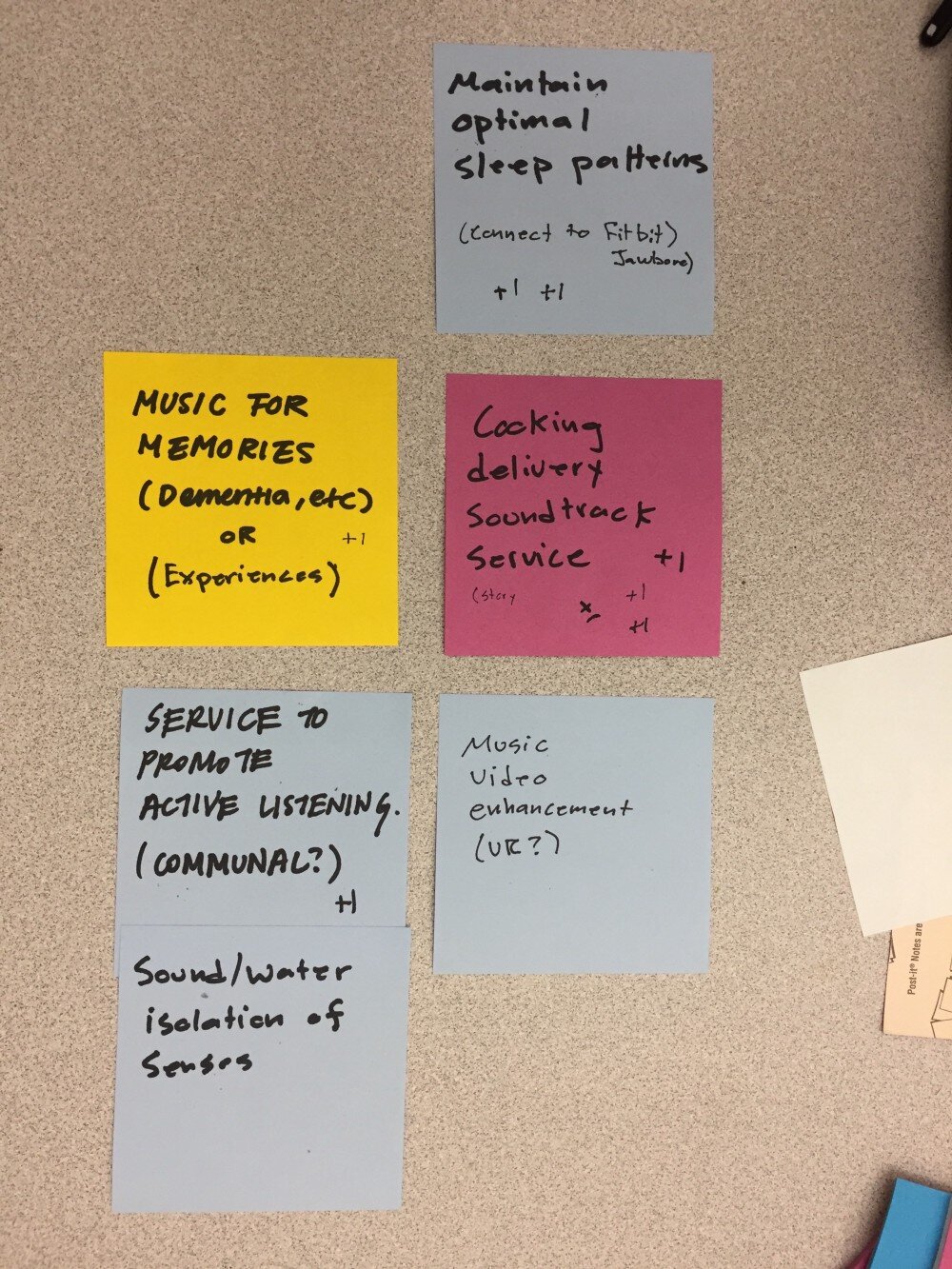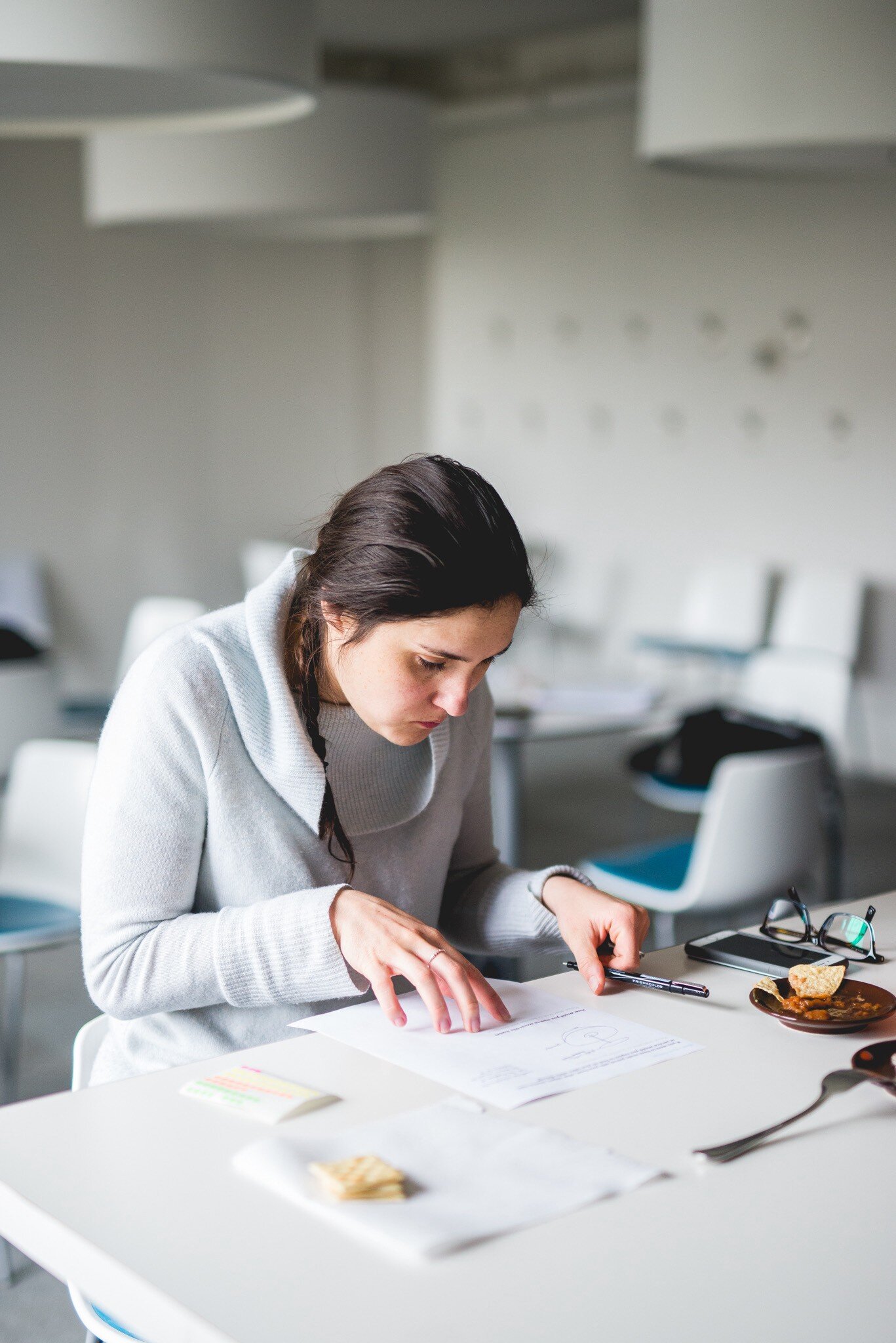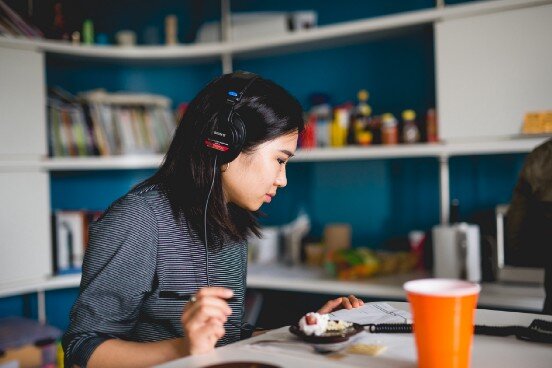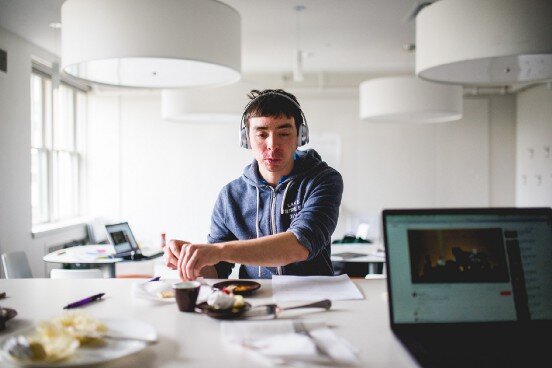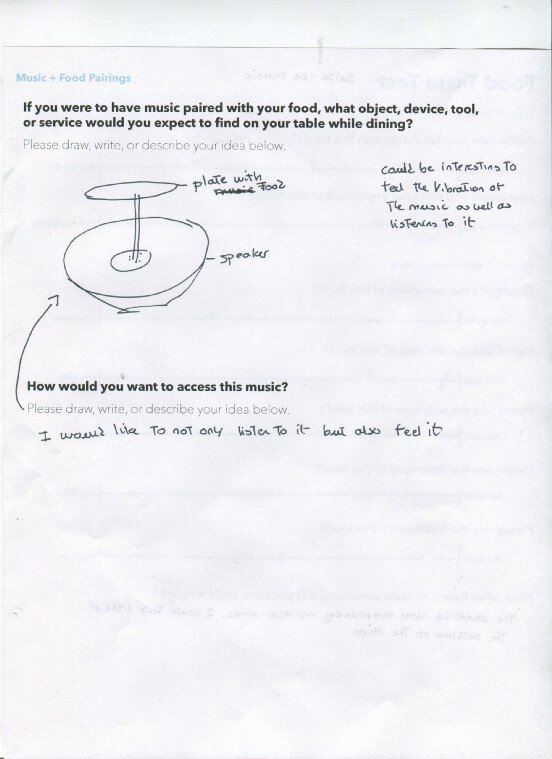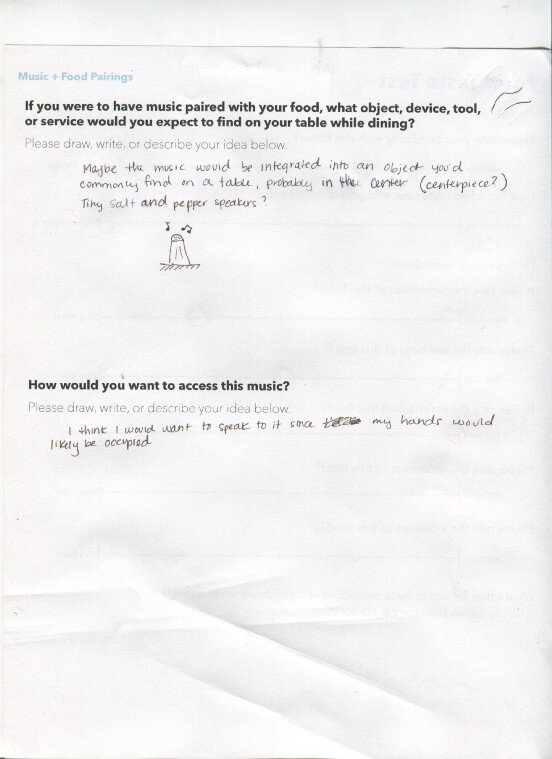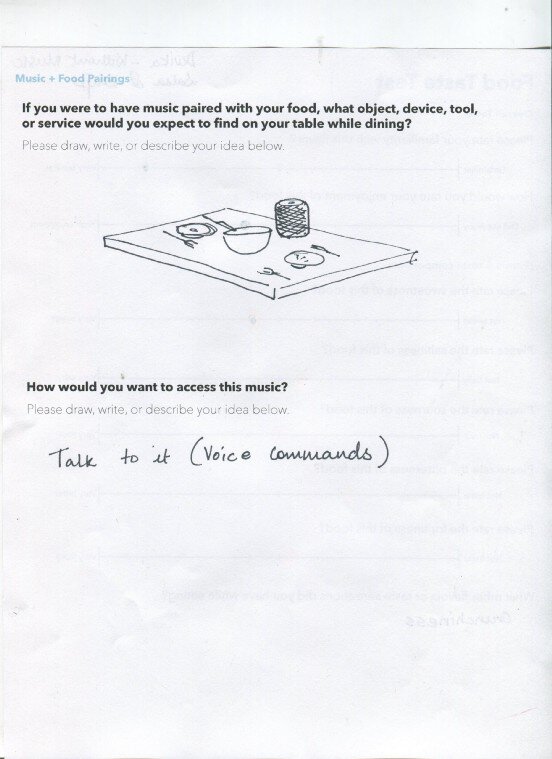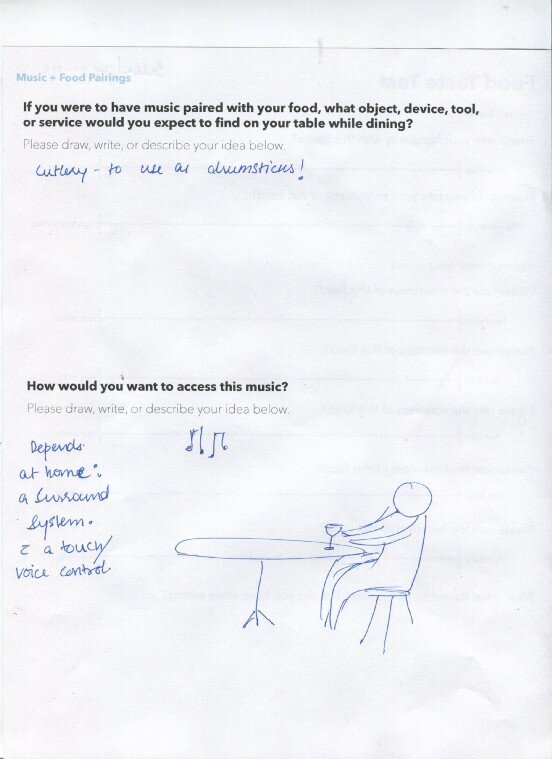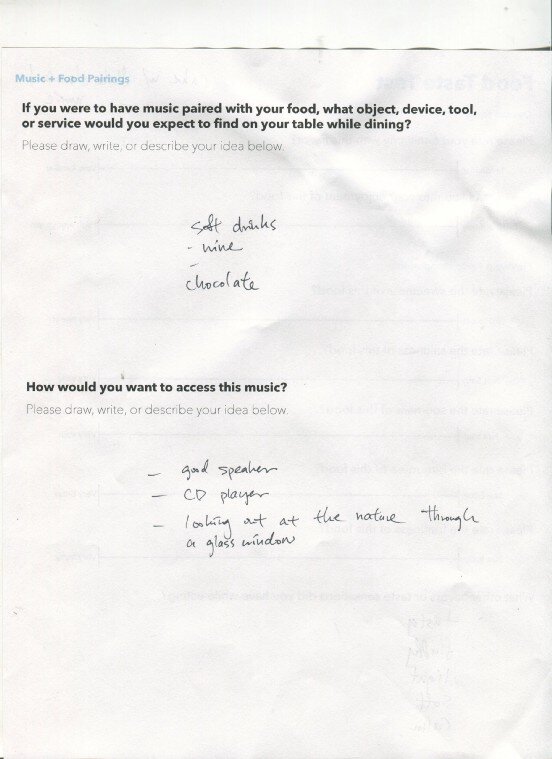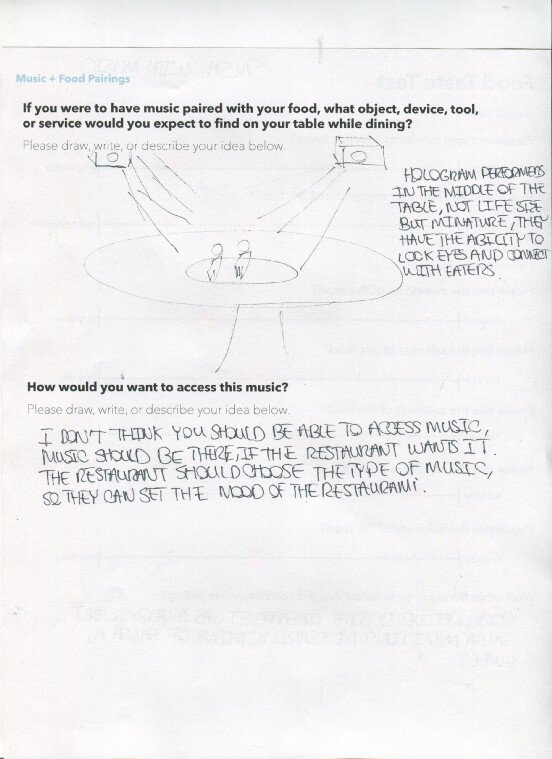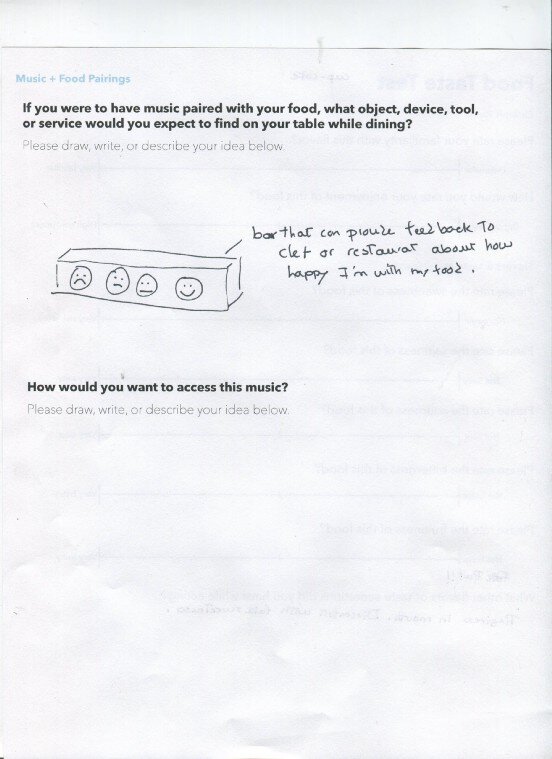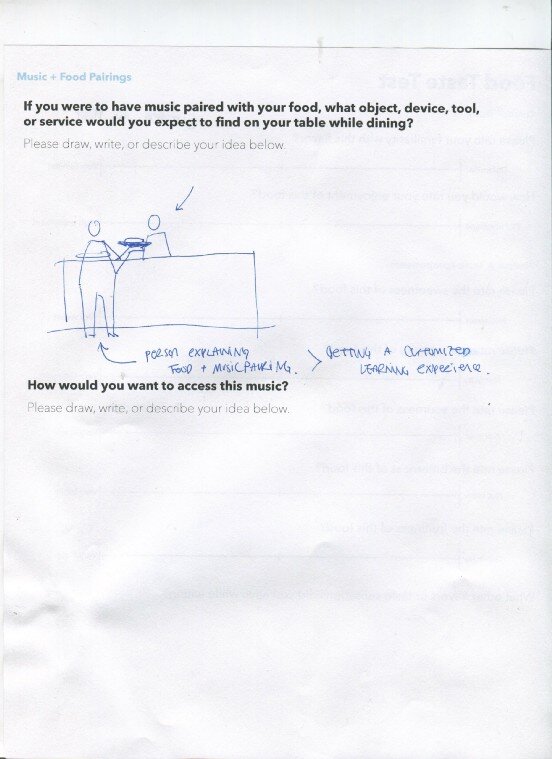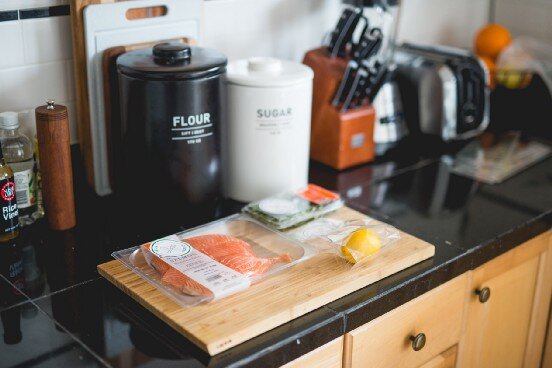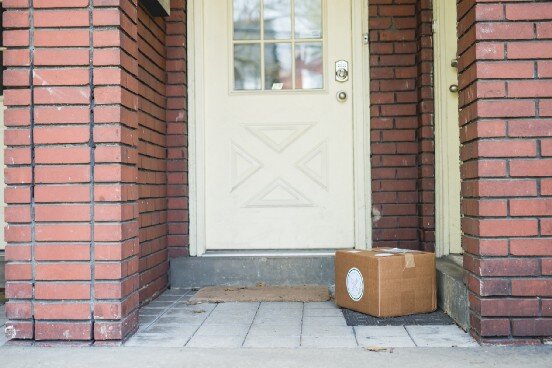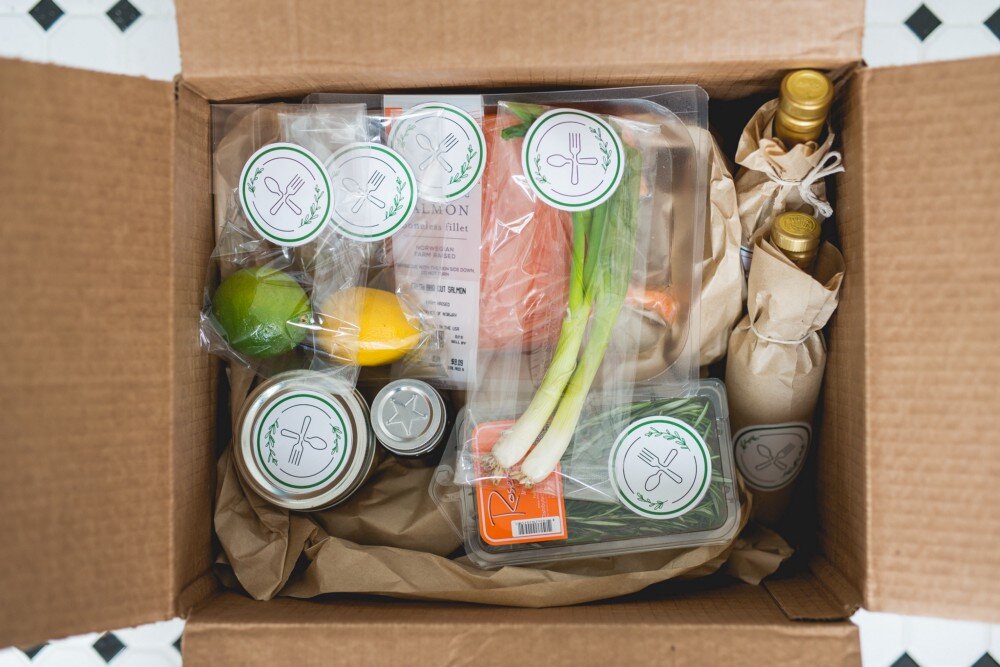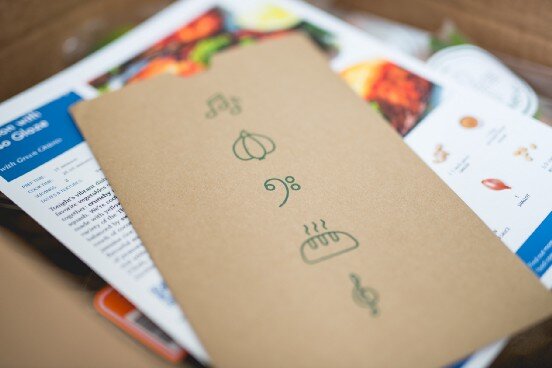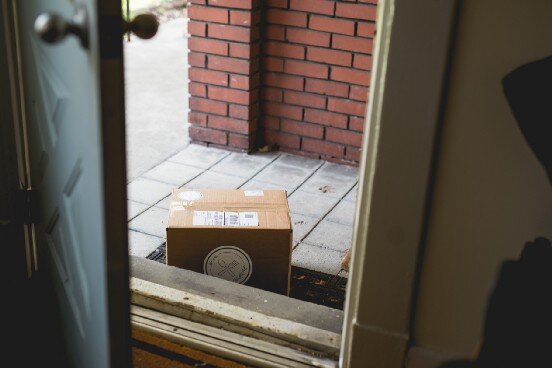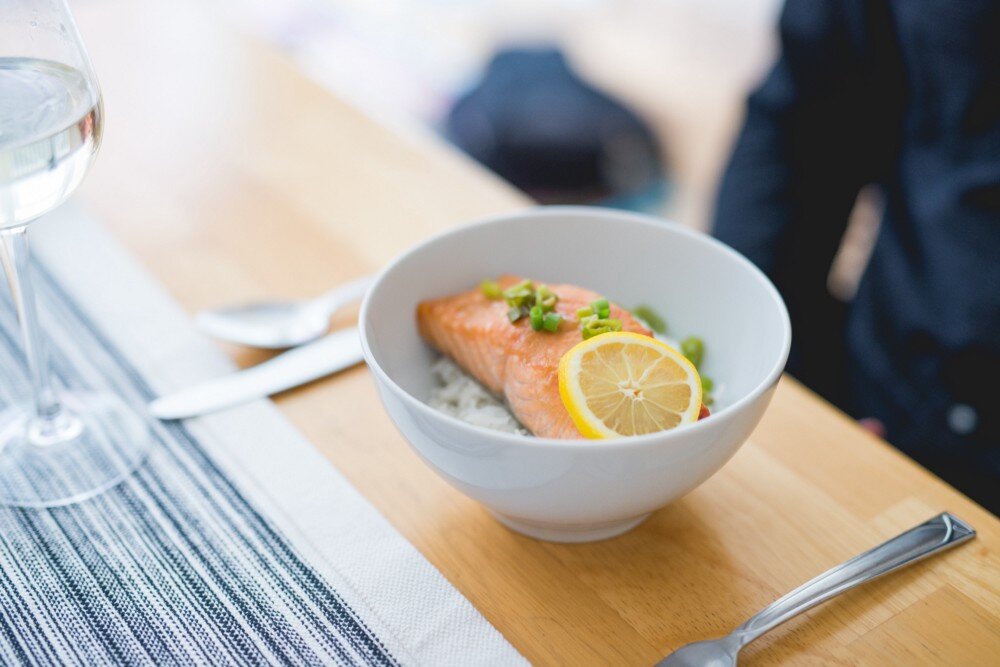Service Design: Sound Bite
Communications | User Research | Service Design | Collaboration
HOW might we incorporate music in order to enhance a daily experience?
With the rise in home cooking popularity with the help of meal prep kits from companies such as Blue Apron or Hello Fresh, we wanted to provide a solution for companies to stick out amongst the competition and give consumers a better experience when cooking from a kit.
Sound Bite is a service that enhances the taste and perception of food through partnerships with food services using synesthetic research on pairing music with foods based on ingredients, flavors and textures; unlike, Turntable Kitchen, Mood Media, or Spotify who only pair food to a music genre (e.g. Mexican food with Mexican music) in order to set the mood of a dining event.
Role & Contribution
I worked on user research, ideation, prototyping, asset creation and documentation.
Deliverables
Physical Prototype, Video, Final Slide Deck, Process Documentation
Design Brief
Design a service in the music industry. It can be anything.
Team
Soonho Kwon, Mary Tsai, Josh LeFevre
PROCESS
Given the broad domain of just, “music", my team decided to first decide where the interest is similar amongst us four. After individually brainstorming potential areas of interest, we created an affinity diagram to highlight key points of mutual interest. The team gravitated towards visual and sensory components to enhance and exaggerate the experience of listening to music. Our main preferences broke down into sense enhancement, spatial music, active/passive listening, and music to enhance experiences.
As a team we honed in on 4 different topics that we were interested in investigating further. Josh looked into spatial relations to music, Mary looked at music’s effects on experiences, Soonho looked into active/ passive listening, and I looked into the relation between music and the senses through secondary research.
Key insights
Passive/active
passive listening is when music is put in the bg
active listening is when one is strictly paying attention to the sound
Senses
music affects sight, smell, and taste
music can evoke vivid memories
music can cause arousal in emotions
Spatial
music immersive technology includes things like surround sound
Experiential
music affects one’s experience with food (high pitch vs low pitch, etc)
Music in restaurants can affect one’s taste buds/ experience
From this, we ideated possible innovations we could create and voted (each person got two +1’s!).
The ideated possibilities were:
Service for memories (assisting individuals with dementia, etc.)
Maintaining optimal sleep patterns
Music for an enhanced cooking experience
Service to promote active listening in a communal setting
Music video enhancement
Sound isolation chamber for active listening
We decided to transform the everyday chore of cooking into a fun and immersive experience. We wanted to access as many of the senses as possible to make the overall experience more memorable. We also liked to explore the concept of active music listening vs passive listening when on the journey of cooking. In addition, we liked to use music as a way for individuals to time their cooking.
In the design research we did, we discovered that there has been some previous research done on synesthetic taste qualities such as higher-pitched music enhancing sweetness and lower pitched and brassy sounds tasting bitter. There has been other individuals who investigated this topic including the Darlingtons and Surreal Gourmet.
Some questions we had to explore were:
How will we get the music?
Where is it coming from?
Is it worth partnering with food delivery systems?
After some feedback, our group looked into these steps:
Personal chefs — symbiosis of food and music coming together
How are you going to get the music and where is it coming from?
Look into what services already do this (existing platforms)
Reach out to interview
Initial survey idea
Story Building
We began thinking through the cooking narrative. Specifically, how could music act as the soundtrack to a cooking experience.
We developed five phases to consider:
Ordering/shopping
Delivery
Preparation (food prep & plating)
Eating
Clean-up
We developed five storyboards based on various potential users of the service. The purpose of developing these stories was to test different aspects of our assumptions and see how others would respond to our ideas in speed dating critique.
Scenario 1: Setting the mood for a romantic evening
Idea: Couple, romantic evening
Purpose: To incorporate music to enhance the mood for a meal
Feedback: Brings up an intersting idea of how could the service be shared or create connection between two people
Scenario 2: Assisting a single individual focusing on meal prep for the week
Idea: Single, busy working professional
Purpose: To incorporate music to assist with the cooking process
Feedback: How does the music actually support me through the cooking process?
Scenario 3: An italian themed friend dinner
Idea: Friends, learning through music
Purpose: To incorporate music to educate about the culture of the cuisine
Feedback: Italian night with friends seems to the most concrete and reusable idea
Scenario 4: A host of a birthday party
Idea: Curated playlist to enhance the mood of an event
Purpose: To incorporate music in order to uplift preparation and execution.
Feedback: I really enjoy having the music react to the mood or enviroment of an event; even cuing up birthday music or signalling the end of a party
Scenario 5: Cooking and muisc as a bonding and learning experience for parent and child
Idea: Parent and child, bonding and learning
Purpose: To incorporate music to educate about cooking and strengthen a relationship
Feedback: Brings up an intersting idea of how could the service be shared or create connection between two people
Overall Feedback:
Would an audio assistant aid in the process
Will the product be served in a physical from (physical recipes & CD,etc) or digital and all available on an tablet
Could this expereince be expanded to other “industries” or activites such as: waking-up DIY, etc
How to pair music I actually like with new food or food that I like. More of a human touch than an AI created playlist
How does the music actually support me through the cooking process?
From the scenarios, it is hard to cearly tell who the stakeholders are
How would the music be distributed?
Could music of authentic dishes combine both this music and current music of an area
Additionally we uncovered some deeper questions to answer or explore.
How would this service be different than just a well curated playlist?
What if the serivce was a one time or select service that those wanting a new experience sought out.
How could we or should we make the music the primary experience?
Could this service serve as an educational experience?
Does VR/AR/MR play a role in this service?
How could we chase more of an authentic experience?
How could local instruments from a cuisine’s region be incorporated?
Main Ideas we would explore:
There exists a relationship between music and food, but we have yet to find a strong symbiosis.
There was much interest in the idea of music playing a bigger role in the service, perhaps not as a supplement but an active role.
There was interest in the cultural implications of music, especially through history in specific locations.
There was interest in the idea of storytelling through music
With some feedback from other groups, we decided to pursue three main concepts:
Music and food as equal agents for telling a story
Music used to transform food preparation into a performance
Transporting the gourmet restaurant experience to the home kitchen
Updated Storyboards
With some deliberation, we arrived at these storyboards ideas:
Scenario 1
This scenario is one in which music and food are used as a storytelling medium. The user would buy into a cultural experience, not a specific meal or piece of music. The music and food might then be used to guide the users through stories of cultural history!
Scenario 2
Scenario two dealt with the association between food and music itself. There is this metaphor that was made that the assemblage of each ingredient is similar to the assemblage of the different elements of a musical piece. We are interested in highlighting these relationships for greater understanding of the cooking process while also increasing musical appreciation.
Scenario 3
Scenario three is one in which music is used more as a branding element that is used for restaurants and food vendors, where there is an association between certain foods and musical pieces. With this scenario, we would focus more on things like personalization?
After this second round of storyboards and feedback, we converged primarily on scenario two, and we progressed with that idea and explored how the service could emerge as we explored the value exchanges.
We speed dated with some classmates to see what attracted them to most to the relationship between food and music. We learned that what people liked the most was the idea of how food can emphasize a journey that the cook goes through and how to utilize music to show those fluctuations in emotion.
We were challenged mainly to understand better where the music comes from, as well as the specific details of how our platform is a service. We were encouraged to think about how restaurants carefully choose their music, and the decision making process that they undergo.
Empathy research
We started off our research with dinner at Apteka to see if how the music might affect the environment. After a few songs, we realized that the music being played was a little strange, mostly consisting of ambient noises or more unique melodies. We spoke with the owner, Tomas (a fellow CMU alum) to see how he curates the music and he said that his objective was to play the sort of songs that take people a little out of their comfort zone. This seems to fit with the vibe of the restaurant because Apteka serves solely vegan food and encourages most diners to eat outside of their comfort zone in that aspect as well.
We had finalized our concept to focus on using music to learn about cooking food, similarly to how newcomers learn different skills from online courses. We wanted to look at how sounds can guide cooks to figure out what kinds of ingredients go well together or which ones are slightly more discordant. We considered using augmented reality or a smart device to identify each of the food products being used, which would then trigger sounds that the cook would hear. One of the examples we used was the Food Network show, Chopped — often these chefs receive ingredients that are completely unrelated and they always know how to pair certain foods together to taste good but if it was a new cook, they would have no idea — they mostly rely on what the recipe specifies. We wanted our service to help cooks learn about the natural blends and characteristics of ingredients, and to be able to fundamentally understand the relationships between the flavors.
We tested our own experiences when cooking and listening to music. When cooking, it seemed like the more methodical processes of chopping, slicing, and peeling were sped up by the music since it provided an alternate source of concentration, whereas the actual cooking process required more attention and the music became less active. There is something interesting in the way the human mind focuses on certain things one at a time and how music fades so easily from the forefront of one’s attention to the background.
We started to do a very basic value flow map to figure out who our partners would be; however, we have to consider the value flow between them and our service and how those organizations would benefit from a partnership. We realized that we should be forming a concept based around the stakeholders/partnerships and we have to keep considering feasibility since we are supposed to be designing for the present time, instead of a few years out.
We reconsidered our concept before moving forward with a blueprint. We had an interview set up with Blue Apron to discuss their business model and how the customer experiences the whole service. We sent out a survey and overall, it seems that people consider music an integral part of the cooking experience, but do not listen to music when eating. This seems to indicate that our idea to tackle the cooking process is definitely valid and that many users would be receptive to a service that teaches better cooking skills through music.
We created five different value flow diagrams as well as service blueprints in order to represent possible partnerships with different music platforms/ options and food delivery service (Blue Apron, Hello Fresh, etc.) vs. restaurants.
Feedback of value flows and service blueprint:
Challenge to think about how the end user would experience our service even thought we are a B2B company
What touch-points we would provide in the home
Testing
Going into user testing we looked at a few key elements:
Testing/prototyping Phase —
Identify the scenarios in which music could be played in a consumption setting/environment
What do people do when eating?
Passive listening or active listening
Does the food taste better or the same?
I’m sure there is an element of them creating the food adding to taste?
Prototyping Goals:
Environment
No distractions
Sharing with other people
No background noise
Music
Playlist
“AI Generated” WOZ
Composed Music
Blue Apron Card
How can we modify/ add to inform the consumption experience?
We’ve read many articles about the impact of music on one’s percption of food. Ben Houge is one of the leaders in this field and shared a concise TEDx talk on the subject.
We created a food taste test to see for ourselves the effect of music on taste in order to test the theories around the affect of music on food perception. We also sought to gain a clear undertanding into how individuals or end consumers may prefer to engage with a service who creates these music–food pairings.
We chose the following foods and paired them with existing music. While the specific pairings of our chosen foods were not in the journal articles we read; we took the data and qualitative insight provided and applied it to the hours of music we listened to in order to create the following music + food pairings:
Prantl’s: Strawberry cupcake with J.S. Bach’s Flute Sonata in B Minor, BWV 1030. III. Presto — Allegro (starting at 2:00min). The piano and flute in this piece were shown to increase one’s perception of sweetness, fruitiness, and flavor pairings.
Trader Joe’s: Pineapple salsa with white corn chips with Bird & Miles’ “best of…” album (starting at 14:45min). The brass trumpet and saxaphone duet were shown to emphasize the saltiness, sourness, bitterness, and complexity of the flavor pairings.
For our user testing we recruited peers from design and other parts of campus to participate. We randomized who listened to music and who ate the food without the music. The taste test went as follows:
Explain the directions for tasting, recording and consumption of the food
Eat a unsalted cracker and swish your mouth with water to clear the palate
Taste and eat the chips and salsa
Record taste perceptions
Eat a unsalted cracker and swish your mouth with water to clear the palate
Taste and eat the strawberry cupcake
Record taste perceptions
Provide insight into how they would interact with a music + food paring service in the home
Key Insights
After testing with eleven participants, we found a significant increase on individuals’ perception of taste when we added music chosen to specifically pair with the food being consumed. For the areas and flavors we focused on, the increase in overall enjoyment and flavor enhancement was similar to studies in our secondary research.
In addition to the taste feedback, we also recieved ideas or insights into what items users may want if they were to bring a music and food paring service into their home.
Final Concept
Sound Bite is a service that enhances the taste and perception of food through partnerships with food services using synesthetic research on pairing music with foods based on ingredients, flavors and textures; unlike, Turntable Kitchen, Mood Media, or Spotify who only pair food to a music genre (e.g. Mexican food with Mexican music) in order to set the mood of a dining event. The recipe card provided by the food service will have a QR code that will send the end user to the specially curated music score. In addition, there will be a supplement card gives the user the opportunity to learn more about the research behind the chosen ingredient and musical pairing through augmented reality. The user will also be able to share their thoughts through social commenting (similar to how SoundCloud provides time-based commentary.
Execution of Concept
Ultimately, we wanted to communicate the idea that we understand the value system of the food delivery services, and wanted to make them more apparent to the consumers. We decided that this video would take place during a business meeting environment, so we should address the business directly, not the end consumer. We wanted to have a video go through the comprehensive research and user flow, highlighting all the touchpoints we designed and prototyped.
We prepared all the assets such as logos, graphic design for branding, figuring out which recipe/music pairing we would use, touchpoints appearing in the video (recipe cards, music info cards), and how exactly we are going to shoot everything in the environment decided upon (Mary’s Kitchen).
